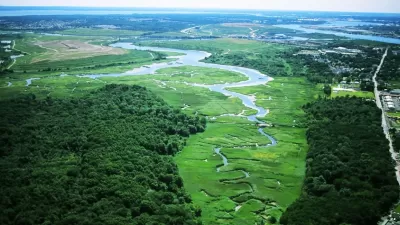Over the last decade, many historic buildings and cultural institutions throughout New York City have disappeared. The result has been the transformation of neighborhoods and the city’s character.

Nathan Kensinger looks at ten buildings that have disappeared from New York City in the last decade, and the effect of those losses on neighborhoods. "As new development projects and rezonings reshaped the city, it also lost countless historic buildings and cultural institutions; dive bars, bungalows, churches, and even entire neighborhoods were wiped off the map."
In Harlem, Manhattanville is an industrial neighborhood that is quickly disappearing as Columbia University expands its campus. The loss, says Kensinger, is buildings and other structures that capture the essence of the city and connect the present to the past. "What has been erased in Manhattanville is the same type of vernacular architecture that is vanishing throughout New York City: diners and tenement buildings, cobblestone streets and slaughterhouses, auto body shops and horse stables.”
He writes about a variety of other places that are completely or mostly gone, including the Cedar Grove Beach Club in Staten Island, the 5 Pointz warehouse and graffiti haven in Long Island City, and the S.W. Bowne Grain Storehouse on the Gowanus Canal.
"New York has always been a dynamic place that changes and reinvents itself. But these recent developments represent something different, where billionaires and politicians conspired to maximize private profits and enrich private developers by destroying thousands of small businesses and dozens of neighborhoods," notes Kensinger.
FULL STORY: A decade of destruction in New York City

Study: Maui’s Plan to Convert Vacation Rentals to Long-Term Housing Could Cause Nearly $1 Billion Economic Loss
The plan would reduce visitor accommodation by 25,% resulting in 1,900 jobs lost.

Placekeeping: Setting a New Precedent for City Planners
How a preservation-based approach to redevelopment and urban design can prevent displacement and honor legacy communities.

Using Old Oil and Gas Wells for Green Energy Storage
Penn State researchers have found that repurposing abandoned oil and gas wells for geothermal-assisted compressed-air energy storage can boost efficiency, reduce environmental risks, and support clean energy and job transitions.

Washington State Plans Ambitious ‘Cycle Highway’ Network
The state is directing funding to close gaps in its existing bike network and make long-distance trips more accessible.

Homeowners Blame PG&E for Delays in ADU Permits
The utility says it has dramatically reduced its backlog, but applicants say they still face months-long delays for approvals for new electrical work.

Rethinking Wildfire Defense: How a Landscape Approach Can Protect Neighborhoods
Post-fire analysis of the Eaton Fire reveals that a landscape approach — including fire-resistant vegetation, home hardening, and strategic planning — can help reduce wildfire risk, challenging assumptions that trees and plants are primary fire hazards.
Urban Design for Planners 1: Software Tools
This six-course series explores essential urban design concepts using open source software and equips planners with the tools they need to participate fully in the urban design process.
Planning for Universal Design
Learn the tools for implementing Universal Design in planning regulations.
Borough of Carlisle
Caltrans
Heyer Gruel & Associates PA
Institute for Housing and Urban Development Studies (IHS)
City of Grandview
Harvard GSD Executive Education
Salt Lake City
NYU Wagner Graduate School of Public Service
City of Cambridge, Maryland




























